Yorkshire Terrier - Breed Facts & Characteristics
Petite but plucky, what they lack in size these diminutive dogs more than make up for in character. Known for their feisty yet friendly temperament, Yorkshire Terriers have bags of personality, make great company and form close attachments to their human families. With all the traits of a true terrier, they make good little watchdogs too. Given all this, and their glorious mane of long silky hair, they are often rightfully described as a ‘miniature lion’.
Official name: Yorkshire Terrier
Other names: Yorkie
Origins: United Kingdom
Tendencia a babear
{score 0 out of 5}Necesidades de aseo
{score 0 out of 5}Nivel de muda de pelo:
{score 0 out of 5}Tendencia a ladrar
{score 0 out of 5}Nivel de energía
{score 0 out of 5}Compatibilidad con otras mascotas
{score 0 out of 5}¿Clima cálido?
{score 0 out of 5}¿Clima frío?
{score 0 out of 5}Apto para vivir en departamento
{score 0 out of 5}Puede quedarse solo
{score 0 out of 5}¿Mascota familiar? *
{score 0 out of 5}
| Macho | Hembra |
|---|---|
| Altura | Altura |
| 18 - 20.5 | 18 - 20.5 |
| Peso | Peso |
| 1.8 - 3.2 | 1.8 - 3.2 |
| Cachorro | Adulto |
|---|---|
| 2 to 10 months | 10 months to 8 years |
| Madurez | Adulto mayor |
| 8 to 12 years | Over 12 years |
| Bebé | |
| Birth to 2 months | |
Tendencia a babear
{score 0 out of 5}Necesidades de aseo
{score 0 out of 5}Nivel de muda de pelo:
{score 0 out of 5}Tendencia a ladrar
{score 0 out of 5}Nivel de energía
{score 0 out of 5}Compatibilidad con otras mascotas
{score 0 out of 5}¿Clima cálido?
{score 0 out of 5}¿Clima frío?
{score 0 out of 5}Apto para vivir en departamento
{score 0 out of 5}Puede quedarse solo
{score 0 out of 5}¿Mascota familiar? *
{score 0 out of 5}
| Macho | Hembra |
|---|---|
| Altura | Altura |
| 18 - 20.5 | 18 - 20.5 |
| Peso | Peso |
| 1.8 - 3.2 | 1.8 - 3.2 |
| Cachorro | Adulto |
|---|---|
| 2 to 10 months | 10 months to 8 years |
| Madurez | Adulto mayor |
| 8 to 12 years | Over 12 years |
| Bebé | |
| Birth to 2 months | |
Tailored nutrition for your Yorkshire Terrier
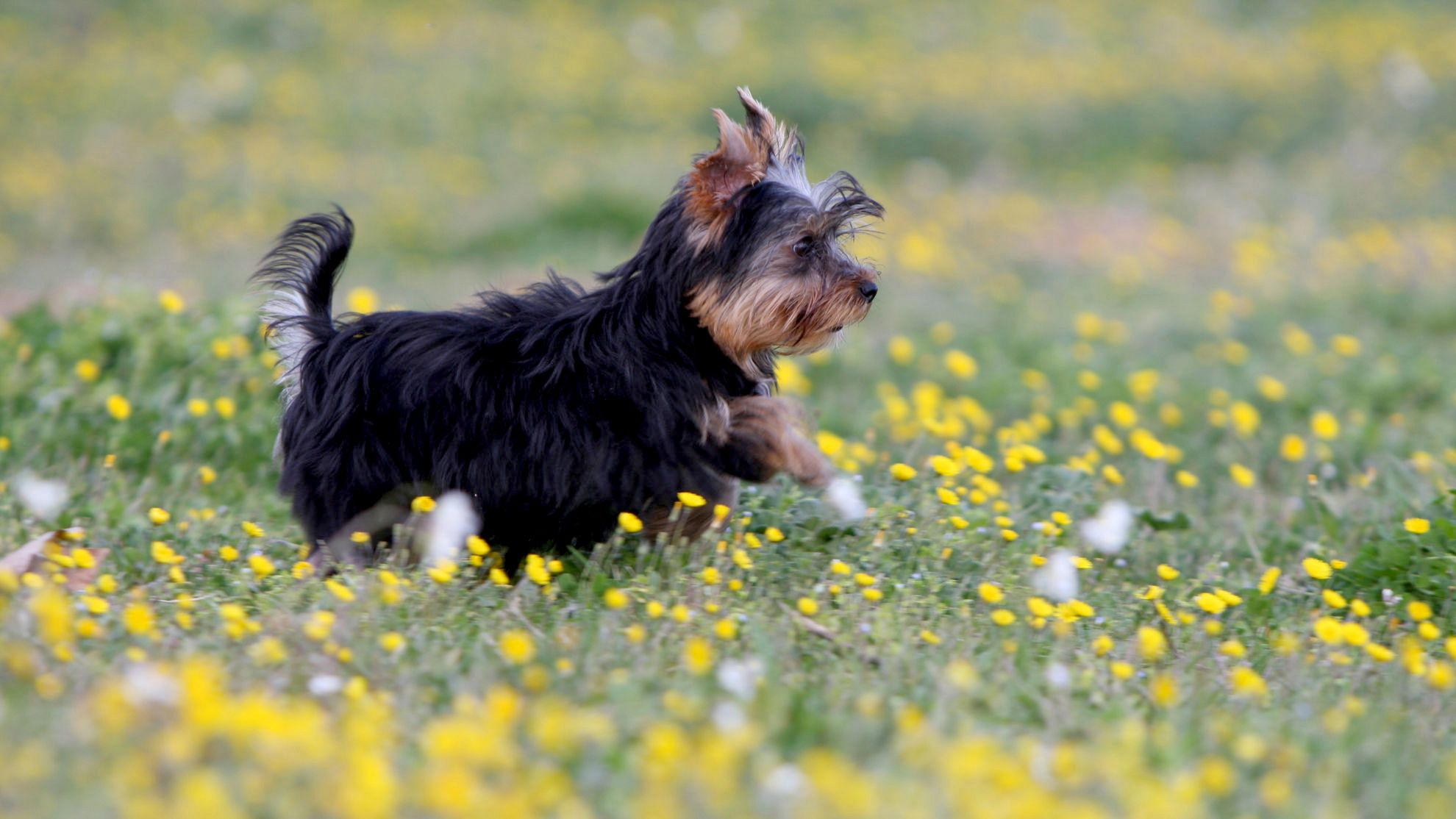
Conoce al Yorkshire Terriers
Todo lo que debes saber sobre la raza
No te dejes engañar por su porte delicado, su melena sedosa y su bonito moño. Puede parecer que siempre están en el salón de belleza, pero el Yorkshire Terrier es un perrito resistente, fuerte e inteligente. Como los terrier, son audaces, intrépidos y tenaces; esto último es un vestigio de sus antiguos días de caza.
Criado en el norte de Inglaterra durante la Revolución Industrial, la función del Yorkshire Terrier era originalmente mantener las minas y fábricas textiles libres de alimañas. No fue hasta finales de la época victoriana cuando se hicieron populares como perro faldero y empezaron, literalmente, a vivir en el regazo del lujo entre las clases altas inglesas.
Ciertamente, con su porte regio, es como si el Yorkshire Terrier siempre hubiera estado destinado a cosas mayores. Pero, en realidad, son una raza amistosa y juguetona, con una naturaleza curiosa que los hace muy divertidos.
Entre otras características de los Yorkshire Terrier, les gusta llamar la atención y estar cerca de sus dueños. Pueden ser bastante protectores con ellos si surge la necesidad y, en algunos casos, tienen el potencial de ser un poco ruidosos al ladrar. Por este motivo, además de su pequeño tamaño, son más adecuados para familias con niños mayores².
Famosos, por supuesto, por su espectacular pelaje sedoso, a menudo lo rematan con un accesorio para el pelo que impide que sus mechones tapen sus ojos. Curiosamente, el pelaje largo y esponjoso del Yorkshire Terrier es excepcionalmente fino y más parecido al pelo humano o de caballo. Requiere un poco de cuidado para mantenerlo brillante, pero el Yorkie es una raza que no muda pelo, por lo que no es necesario aspirar el sofá.
Al ser una de las razas de perro más pequeñas, el tamaño compacto del Yorkshire Terrier le permite adaptarse bien a la mayoría de los hogares. Excelente compañía para quien vive solo, el Yorkie es una de las razas más longevas y puede superar su adolescencia. No es de extrañar que el Yorkshire Terrier sea una de las razas de perros toy más populares del mundo¹.
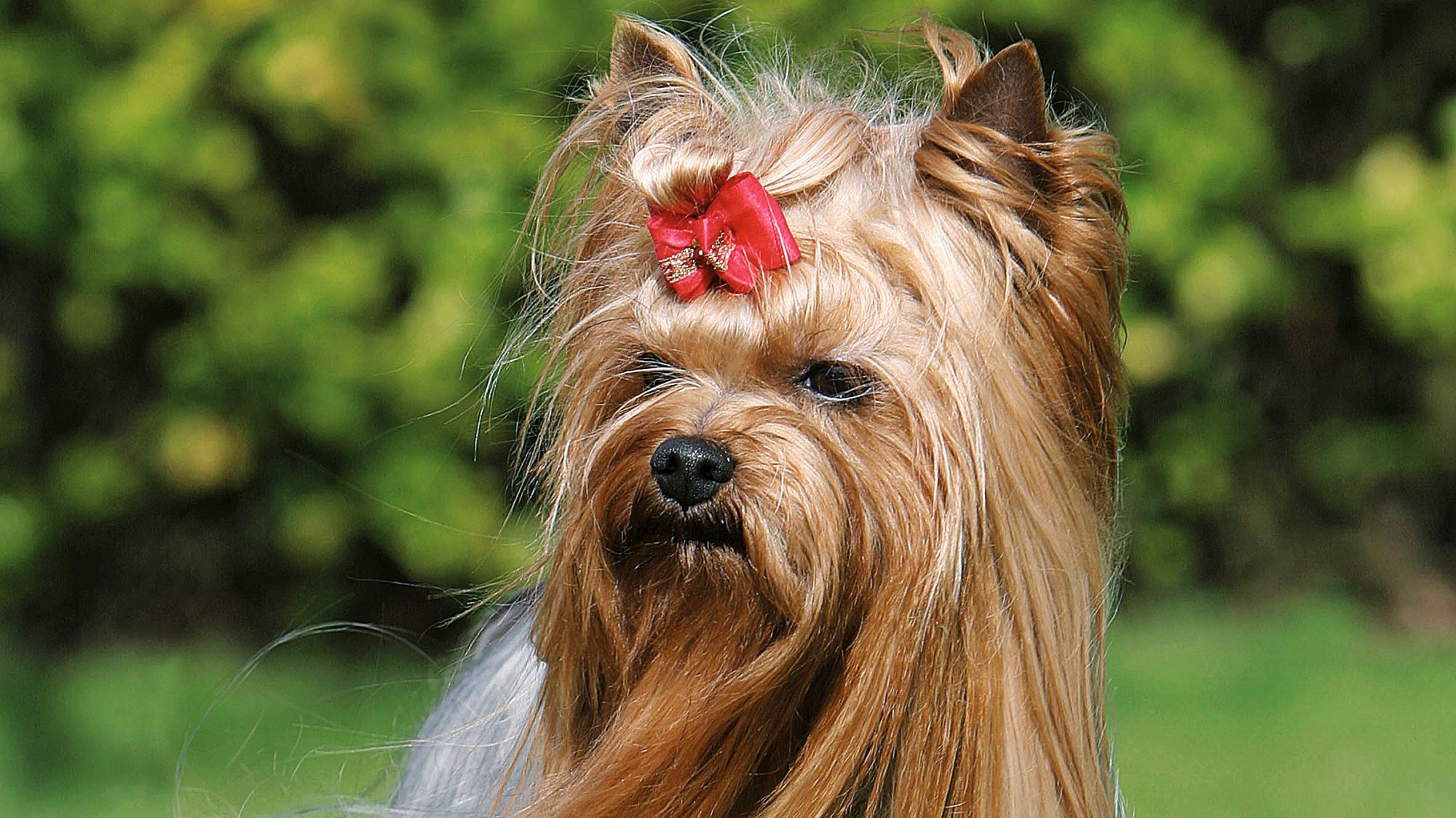
Datos sobre los Yorkshire Terriers
1. A tale of two terriers
In L. Frank Baum’s illustrated book, The Wonderful Wizard of Oz, the little dog Toto appears to have been a Yorkshire Terrier. However, when the story was made into a film, the starring role was stolen by a Cairn Terrier. The Yorkies got their revenge, though, with an appearance in the Audrey Hepburn movie, Funny Face, which featured her own dog.
2. Bending your ear...
In other fun facts about the Yorkshire Terrier, did you know that the puppies are born with floppy ears? What is more, in some cases, they remain that way for life. This is only an issue if you intend to show your Yorkie, as the judges look for upright ears in the breed, but it is in no way a problem for the dog. Also, many people find it a rather endearing quality.
Historia de la raza
Procedentes del noreste de Inglaterra, los Yorkshire Terrier reciben su nombre del condado del que son originarios. Lo que quizá sea un poco más inesperado, es que su historia está estrechamente vinculada a la Revolución Industrial.
Durante el siglo XIX, era habitual que mineros y trabajadores de los molinos viajaran a la región en busca de trabajo; entre ellos había varios escoceses. Estos aspirantes a trabajadores, del norte, trajeron consigo sus propias razas de terrier. Con el tiempo, estos perros escoceses se cruzaron con las variedades inglesas, lo que dio lugar a la raza Yorkshire Terrier que hoy conocemos y amamos.
Aunque no podemos estar seguros de su ascendencia exacta, se cree que el Yorkshire Terrier surgió del cruce de al menos tres razas de terrier: el antiguo Black and Tab, el Maltés y el Skye. En cualquier caso, estos pequeños y resistentes Terriers adquirieron fama de excelentes perros de caza y se utilizaban para capturar pequeñas alimañas en las minas y molinos. La raza fue reconocida oficialmente por el Kennel Club de Inglaterra en 1886.
A finales de la época victoriana, el Yorkshire Terrier se convirtió en un popular animal de compañía, un perro faldero preferido por las clases altas inglesas. Sin embargo, la popularidad de la raza pronto se extendió mucho más allá de Yorkshire, hasta los Estados Unidos de Norteamérica. Desde entonces, el Yorkie es uno de los favoritos en todo el mundo.
De la cabeza a la cola
Características físicas del Yorkshire Terrier
1.Head
2.Face
3.Body
4.Fur
5.Tail
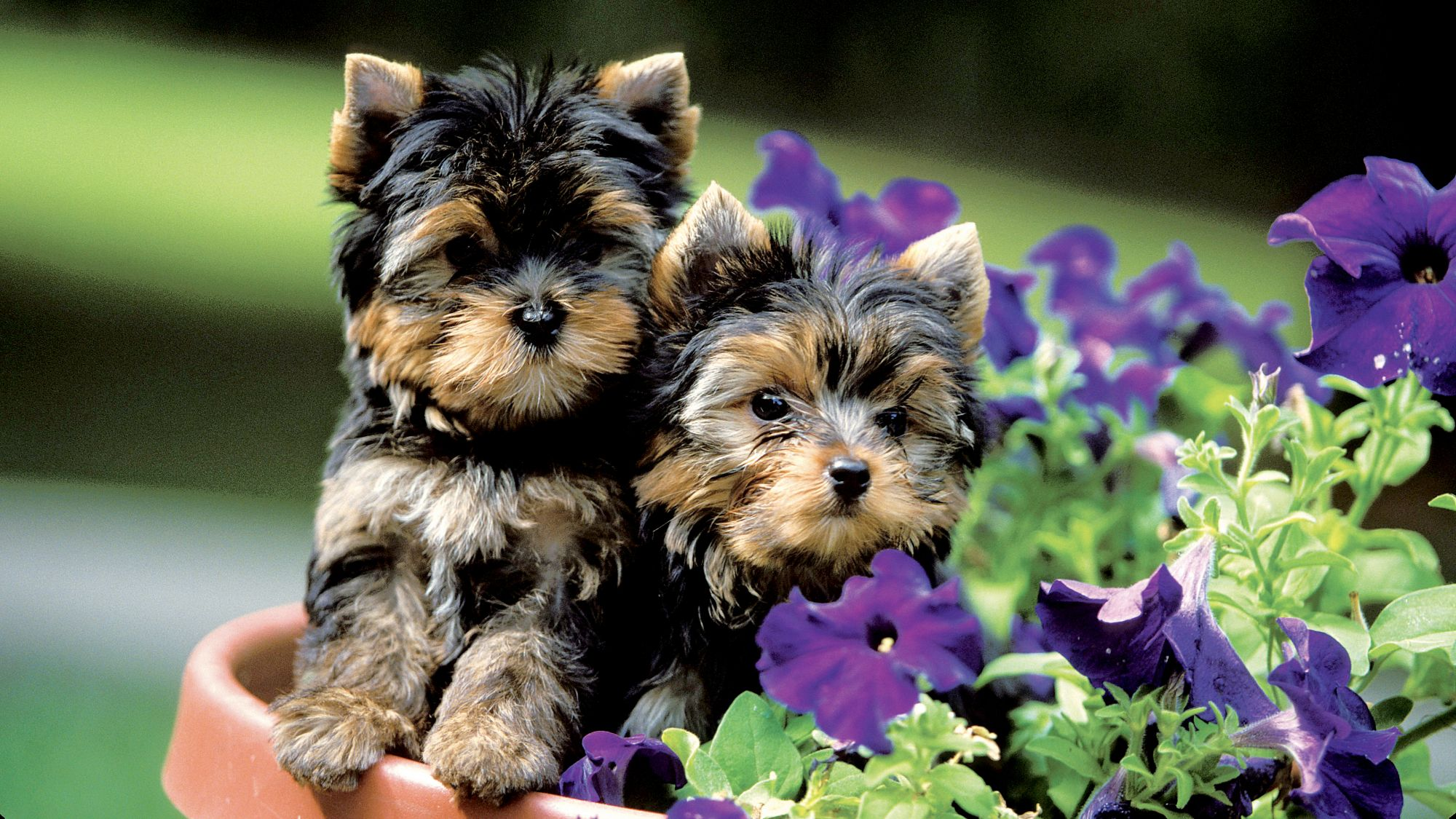
Aspectos a tener en cuenta
Desde rasgos específicos de la raza hasta una descripción general de la salud, aquí hay algunos datos interesantes sobre tu Yorkshire Terrier
The little legs of the Yorkie need extra-special care
One of the most common complaints in the Yorkshire Terrier is a dislocated kneecap (luxating patella). Once known as ‘trick knee’ in humans, it occurs when the kneecap literally pops out of place. Symptoms can include obvious discomfort, limping or an odd ‘skipping’ walk – and it can also lead to arthritis in later life. As always, prevention is better than cure, so it’s best to keep your Yorkie away from anywhere they might try and jump. If, however, the condition does occur, there is plenty that can be done, ranging from muscle-building exercises and weight management to anti-inflammatory medications. Surgery has a good success rate.
It’s better to use a harness rather than a lead
Like many small breeds of dog, Yorkshire Terriers can be prone to a condition known as tracheal collapse, which is a narrowing or collapsing of the windpipe. This can cause an obstruction of the airways resulting in symptoms ranging from a honking cough to noisy breathing and gagging sounds. In severe cases, it can also cause fainting. Caused by a genetic weakness, the condition is often triggered if a Yorkshire Terrier lunges forward when wearing a collar and lead, or if the owner pulls back too hard. Therefore, it is highly recommended to opt for a harness, which also helps with better control.
It’s important to look after their teeth and gums
Another thing to watch out for with Yorkshire Terriers is dental health. Because of their smaller, more crowded mouths, they can be more prone to problems such as gingivitis (an inflammation of the gums) or periodontal disease (where the tooth’s entire support structure is affected).
In more serious cases, the resulting bacteria can spread around the body and damage the liver and kidneys, so it’s important to stay on top of this. The good news, though, is that daily brushing will help keep problems at bay. With teeth kept clean and healthy, the chance of infected gums is reduced in the first place. A good diet is vital, too, as are regular check-ups with a professional.
Nutrición a la medida para Yorkshire Terriers
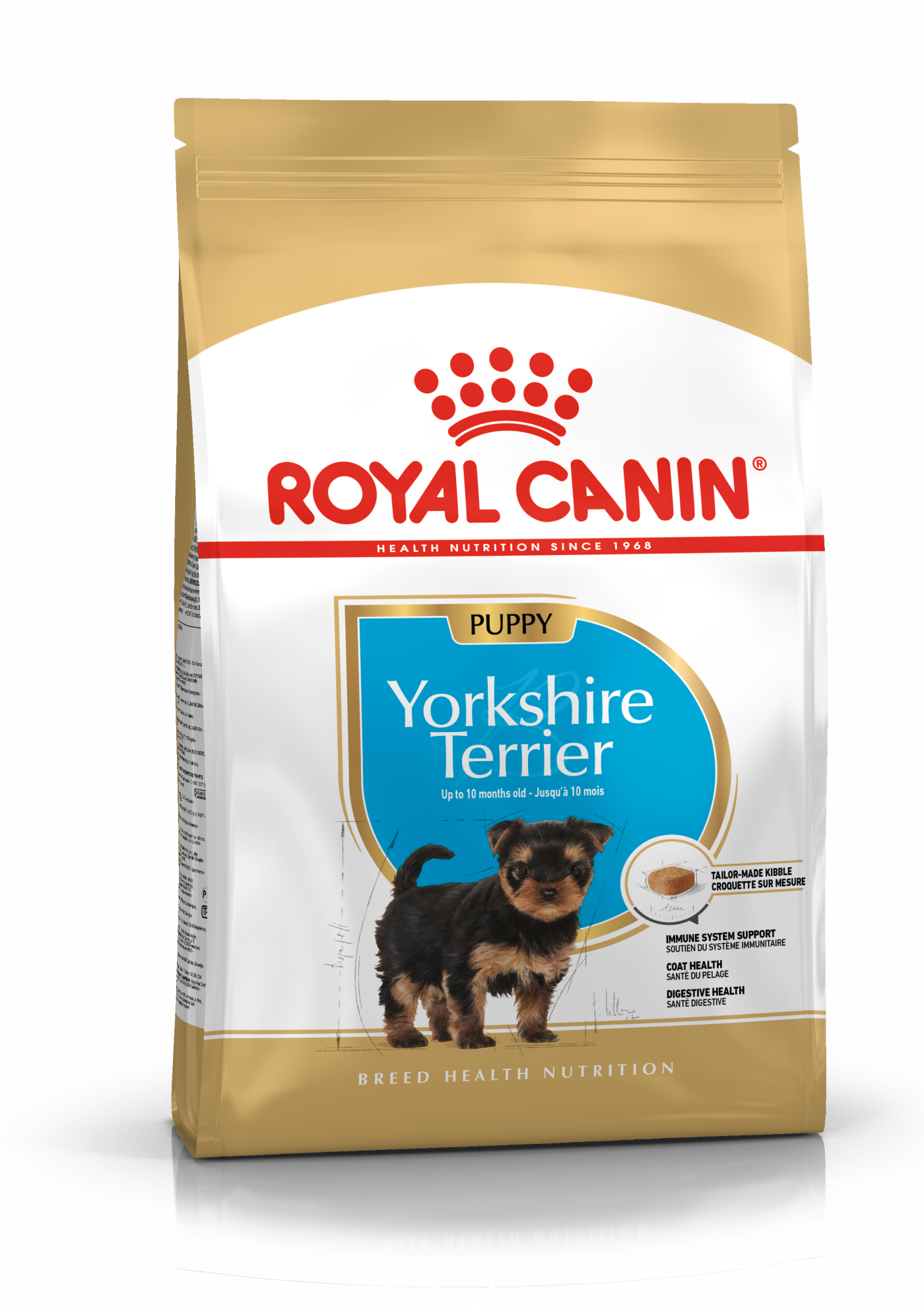
When choosing food for a Yorkshire Terrier, there are many factors to consider: their age, lifestyle, activity level, physiological condition, and health, including potential sickness or sensitivities. Food provides energy to cover a dog’s vital functions, and a complete nutritional formula should contain an adjusted balance of nutrients to avoid any deficiency or excess in their diet, both of which could have adverse effects on the dog. The following recommendations are for healthy animals. If your dog has health problems, please consult your veterinarian who will prescribe an exclusive veterinary diet. Clean and fresh water should be available at all times to support your Yorkshire Terrier’s urinary health. In hot weather and especially when out exercising, bring water along for your dog’s frequent water breaks.
Similarly, a puppy’s teeth – starting with the milk teeth, or first teeth, then the permanent teeth – are an important factor that needs to be taken into account when choosing the size, shape, and texture of kibble. This growth phase also means high energy needs, so the food must have a high energy content (expressed in Kcal/100g of food), while concentrations of all other nutrients will also be higher than normal in a specially formulated growth food. Maintaining the health of their long and silky coat requires nutrients such as omega-3 fatty acids (EPA-DHA), omega-6 fatty acids, borage oil, and biotin. It is recommended to split the daily allowance into three meals a day until they are six months old, then to switch to two meals per day.
A Yorkshire Terrier puppy’s requirements, in terms of energy, protein, minerals, and vitamins, are much greater than those of an adult dog. They need energy and nutrients to maintain their body, but also to grow and build it. Until they are 10 months old, a Yorkshire Terrier puppies’ immune system develops gradually. A complex of antioxidants - including vitamin E - can help support their natural defences during this time of big changes, discoveries, and new encounters. Their digestive functions are different from an adult Yorkshire Terrier’s, too: their digestive system is not mature yet so it’s important to provide highly digestible proteins that will be effectively used. A balanced intake of fibres, such as psyllium, can help facilitate intestinal transit and prebiotics (FOS) can support digestive health and balance of intestinal flora, which contributes to good stool quality.
Throughout their life, it is important to avoid feeding your Yorkshire Terrier human foods or fatty snacks. Instead, reward them with kibble taken from their meal allowance in order to prevent excessive weight gain.
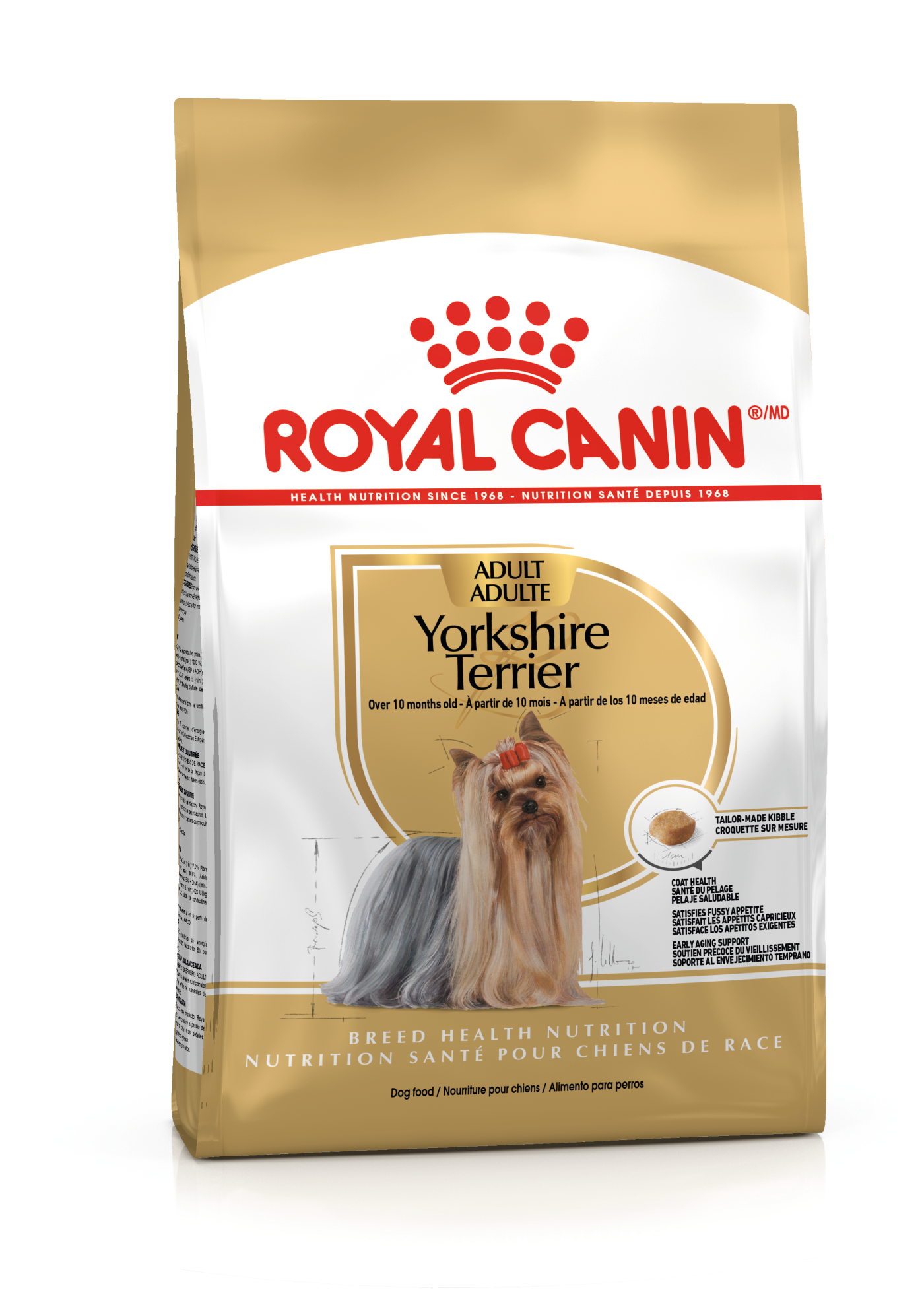
The main nutritional goals for adult Yorkshire Terriers are:
Preserving the health and beauty of the skin and coat with the enriched provision of essential fatty acids (omega-3 - EPA-DHA - and omega-6), borage oil, and biotin.
Satisfying their fussy appetite. The size of the kibbles should be very small and adapted to the miniature jaw of Yorkshire Terriers in order to avoid problems with picking up food. Combined with great aromas and flavours, this will help stimulate their finicky appetite.
Maintaining an ideal body weight by using highly digestible ingredients and keeping the fat content at a sensible level.
Maintaining a healthy digestive system. A diet formulated with a balanced intake of fibres, to help facilitate intestinal transit, and with highly digestible proteins contributes to good stool quality.
For Yorkshire Terriers living mainly indoors, because of reduced activity, it is important to strictly follow the feeding guidelines written on the package in order to prevent excessive weight gain and to do so for sterilised Yorkshire Terriers as neutering is a factor for overweight dogs.
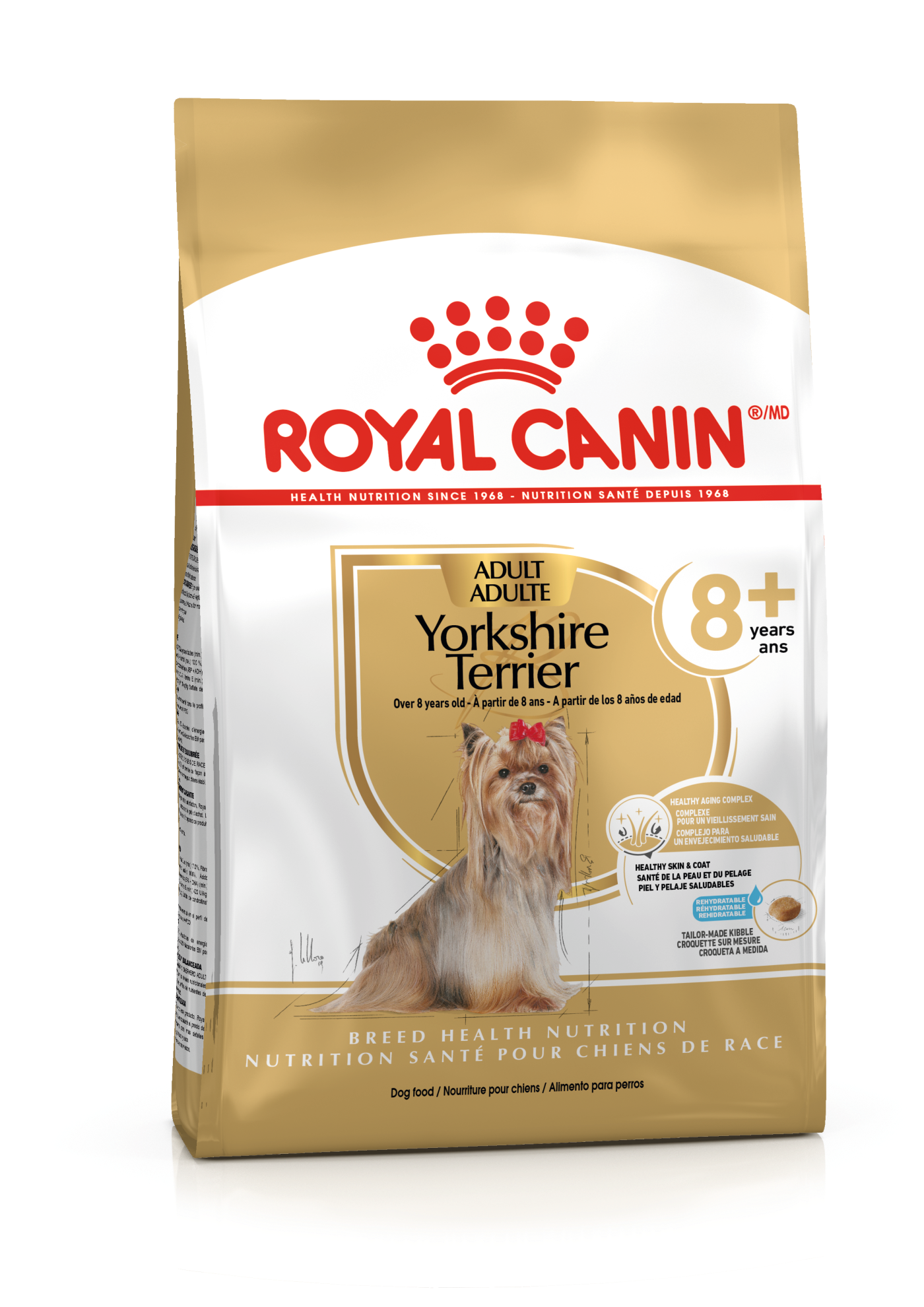
After 8 years old, Yorkshire Terriers start facing the first signs of ageing. A diet enriched with antioxidants helps maintain vitality, and key nutrients, such as taurine, help support good cardiac function. Ageing is also accompanied by the modification of digestive capacities and particular nutritional requirements, so food for ageing Yorkshire Terriers should have the following characteristics:
Higher vitamin C and E content. These nutrients have antioxidant properties, helping to support the body’s cells against the harmful effects of the oxidative stress linked to ageing.
Highly digestible proteins, a blend of prebiotics and fibres to help promote a balanced intestinal flora and optimal stool quality.
An adapted phosphorous content to help slow down the gradual deterioration of kidney function
A higher proportion of the trace elements iron, zinc, and manganese to help maintain good condition of the skin and coat
A higher quantity of polyunsaturated fatty acids (omega-3 and omega-6 fatty acids) to maintain the quality of the coat. Dogs can normally produce these fatty acids, but ageing can affect this physiological process.
As they age, dogs increasingly suffer from teeth problems. To ensure they continue to eat in sufficient quantities, the size, shape, and texture of their kibble needs to be tailored to their jaw. Kibble may be softened with warm water which can bring out the aroma and allow for easier eating. A formula that contains calcium chelators will support dental health by helping to reduce tartar formation.
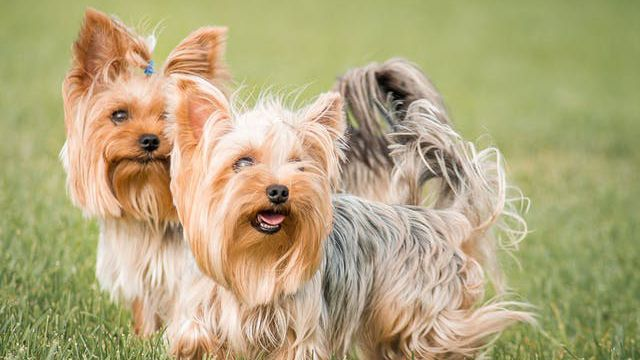
Cuidados del Yorkshire Terrier
Consejos de aseo, adiestramiento y ejercicio
Despite their coiffured good looks, Yorkies are still terriers through and through. So they do require a reasonable amount of physical activity every day. With their history as working dogs, they also benefit from being occupied rather than too sedentary. Boredom can lead to your Yorkshire Terrier barking more than is necessary. A daily walk is the minimum and ideally two if possible. They also enjoy playing games with their owners – especially if it involves a ball – as well as plenty of interaction. But that should be a given.
Despite their long silky tresses, Yorkshire Terriers don’t tend to shed. However, their unique coat, closer to human hair, does require a gentle daily brushing to keep it looking its lustrous best. Extending almost to the ground if left to its own devices, it may also need an occasional trim. Regular baths are recommended – which is a chance to give their ears a check too – and nails should be clipped as needed. Other Yorkshire Terrier grooming tips include cutting their fringe to avoid it falling in their eyes. It can also be tied in that famous topknot with a bow. To keep things simple, some owners choose to have them clipped all over.
Though it’s true that they can be a bit stubborn at times, Yorkshire Terriers are generally eager to please. They are also fast learners and enjoy mental stimulation. This means they respond well to reward-based training. As this can also help cement the bond between dog and owner, it’s often an enjoyable process for both. Afterwards, Yorkshire Terriers can also excel at dog agility and obedience classes – and some go on to become excellent therapy dogs. Like other toy breeds, they can be a little slower to become house-trained, but they’ll get there with patience. In addition, early socialisation with people and animals will reap dividends later.
Despite their coiffured good looks, Yorkies are still terriers through and through. So they do require a reasonable amount of physical activity every day. With their history as working dogs, they also benefit from being occupied rather than too sedentary. Boredom can lead to your Yorkshire Terrier barking more than is necessary. A daily walk is the minimum and ideally two if possible. They also enjoy playing games with their owners – especially if it involves a ball – as well as plenty of interaction. But that should be a given.
Despite their long silky tresses, Yorkshire Terriers don’t tend to shed. However, their unique coat, closer to human hair, does require a gentle daily brushing to keep it looking its lustrous best. Extending almost to the ground if left to its own devices, it may also need an occasional trim. Regular baths are recommended – which is a chance to give their ears a check too – and nails should be clipped as needed. Other Yorkshire Terrier grooming tips include cutting their fringe to avoid it falling in their eyes. It can also be tied in that famous topknot with a bow. To keep things simple, some owners choose to have them clipped all over.
Though it’s true that they can be a bit stubborn at times, Yorkshire Terriers are generally eager to please. They are also fast learners and enjoy mental stimulation. This means they respond well to reward-based training. As this can also help cement the bond between dog and owner, it’s often an enjoyable process for both. Afterwards, Yorkshire Terriers can also excel at dog agility and obedience classes – and some go on to become excellent therapy dogs. Like other toy breeds, they can be a little slower to become house-trained, but they’ll get there with patience. In addition, early socialisation with people and animals will reap dividends later.
7/7
Todo sobre los Yorkshire Terriers
If you’re wondering how long Yorkshire Terriers live for, the average age is around 12 to 15 years. However, they can potentially live into their late teens. On average, female Yorkshire Terriers live an extra one-and-a-half years compared to males.
One question that is asked a lot is, do Yorkshire Terriers shed? While they are known for their long, flowing coats, they actually shed no more than normal human hair. On a related topic, you might be wondering if the Yorkshire Terrier is hypoallergenic. The answer is no, as there is, in fact, no such thing as a hypoallergenic dog. The main allergen is produced by all breeds regardless of their coat.
Other breeds that might interest you
Otras razas que pueden interesarte
Sources
- Veterinary Centers of America https://vcahospitals.com/
- Royal Canin Dog Encyclopaedia. Ed 2010 and 2020
- Banfield Pet Hospital https://www.banfield.com/
- Royal Canin BHN Product Book
- American Kennel Club https://www.akc.org/
Like & share this page